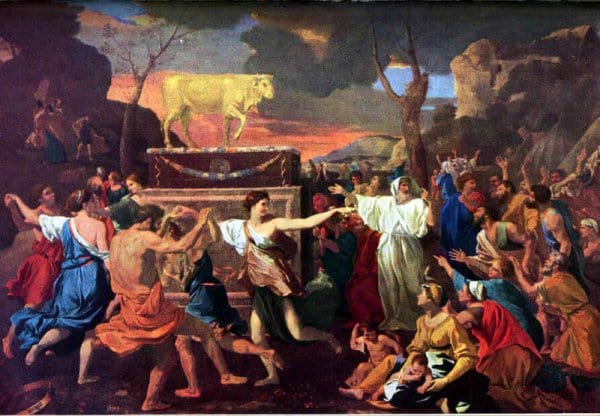
The sight of the stone tablets being hurled to the ground and broken, and the spectacle of Moses, the meek man of God, behaving with fury must have shocked even the wayward Israelites (Exodus 32).
Their debauchery had come to an end with the return of Moses to the Israelite camp. During his long absence on Mount Sinai alternative explanations of how Israel had been delivered from slavery and the Egyptian armies began to circulate. Aaron was petitioned for radical changes of religious orientation within the covenant community. Under pressure he acceded and, to his shame, conceived the idea of worshipping ‘the Lord’ under the image of a golden calf. The people gladly gave him their golden earrings to melt down to make the idol. Once the golden calf was formed the people gathered to sacrifice to it and to credit it with the powers of redeeming the nation from bondage. They indulged in sensual and immoral cultic worship.
To this scene of wild abandon Moses returned. He had brought with him two stones freshly inscribed with the Ten Commandments. On these tablets God himself had written with his finger, but, overcome with anger at the sight of the people so given over to faithless idolatry, Moses destroyed the tablets there and then. Severe punishments followed as God plagued the Israelites for their sin; twenty-three thousand of them (1 Corinthians 10:8) were killed, the rest spared only because of Moses’ intercession.
One who was not rebuked, however, was Moses himself, in spite of his treatment of the commandments. Instead God gave him a fresh set of the same on new stones (Exodus 34). This time the stones were unharmed, and were later placed in the acacia wood and gold Ark of the Covenant (Deuteronomy 10:2). There they remained for many centuries.

Full of symbolism
These events are full of symbolism. The first tablets broken up represent the natural inability of God’s people to keep the law, even though that law comes straight from the finger of a holy God and the people to whom it is given have been redeemed (Exodus 20:2). The second set, placed inside the Ark, represents the perfect fulfilment of the law by the Lord Jesus Christ as a man. The Ark is redolent of Christ, for his body is the temple (John 2:19), his flesh the veil (Hebrews 10:20) and his death on the cross the ‘mercy seat’ or propitiation for his people’s law-breaking (1 John 2:2). The law remained intact and unbroken in Christ’s human nature, for as a man he fulfilled all righteousness (Matthew 3:15). Jesus kept the all the requirements of God’s holy law on behalf of his people. His life of pure love and holiness expressed all that God willed for man.
Thus the law which Moses dashed to pieces, Jesus preserved intact. What Moses declared as irreparably ruined, Jesus lived out in a life of perfect holiness before his Father. The law broken evoked hot anger from Moses, the mediator of the old covenant, and direct judgement from God; the law fulfilled by Jesus, the mediator of the new covenant, brought words of public approval from the Father and the empowering of the Holy Spirit for the work of redemption (Matthew 3:13-17).
Antagonism
We learn from this contrasted fate of the two sets of stone tablets that there is a divinely instituted antagonism between the ministries of Moses and Jesus Christ (John 1:17). Come to God, as Moses did, with the Ten Commandments in your hand, plead your own obedience to God’s law, and the sound of splintering stone soon fills the air. The law can never be fulfilled that way: ‘The wrath of God is revealed from heaven against all ungodliness and unrighteousness of men’ (Romans 1:18).

On the other hand, draw near to God by way of the mercy seat, let the propitiatory sacrifice of Jesus be your only plea, and you will be accepted as righteous for Christ’s sake. To come this way is to come to God empty-handed, without any pretence at law-keeping. The righteousness of the law has been accomplished in the life of Jesus and it becomes yours through faith in him. Luther puts it like this, ‘I will have none of Moses with his law, for he is an enemy to my Lord and Saviour Christ. If Moses will go to law with me, I will give him his dispatch, and say: Here stands Christ!’
Sanctification
The Ark, containing the second set of commandments, also shows that Israel can only be truly sanctified in Christ. The people were condemned, not sanctified, by exposure to the first set of tablets. The handwriting of God’s law, visible to the Israelites until Moses hurled it on the ground, only showed their guilt: ‘Thou shalt have no other gods before me. Thou shalt not make unto thee any graven image. Thou shalt not commit adultery.’
However, those same commandments enclosed within the Ark of the Covenant, preserved but covered, meant that Israel’s sin was hidden from view and the nation was preserved as a people for God (Exodus 25:21-22). The tablets were placed inside the Ark under the cherubim, the symbols of God’s glorious presence with his people. The law was, therefore, by virtue of its location always at the front of the marching tribes, and in the middle of their encampment (Psalms 68, 132). So Jesus Christ, the Son of God, is made unto us sanctification (1 Corinthians 1:30), waking or sleeping, watching or warring. We have no other holiness apart from his.

How to keep the law
This symbolism also shows us how believers are motivated and empowered to keep the law in the face of conflict with the world, the flesh and the devil. Success is not to be sought by trembling before an angry Moses poised to demonstrate a broken law in open accusation of our failings (2 Corinthians 3:7). It is through the Spirit of Christ leading us in the spiritual warfare. Paul put it this way: ‘What the law could not do in that it was weak through the flesh, God did by sending his own Son in the likeness of sinful flesh, on account of sin: he condemned sin in the flesh.’ He then adds ‘that the righteous requirement of the law might be fulfilled in us who do not walk according to the flesh but according to the Spirit’ (Romans 8:4). Christ writes the law upon the heart of those in whom he dwells so that they desire to obey God in all that they do and glorify him through their life and walk (Hebrews 8:10; 2 Corinthians 3:3,6).
Believers should not need the external restraints of God’s law, for ‘the law is not made for a righteous man, but for the lawless and disobedient, for the ungodly and for sinners, for unholy and profane…’ (1 Timothy 1:9). The righteous man ‘waits not to learn from [the law] what is his duty, since he has the grace of the Spirit within to direct him. For the law was given, that men might be chastened by fear of its threatenings. But the tractable horse needs not the curb, nor the man that can dispense with instruction the schoolmaster’ (Chry-sostom). As we walk by the Spirit we bring forth righteousness (Romans 8:1-4). This righteousness is described and tested in terms of God’s law, for it is the ‘righteousness of the law’, and yet wisdom to practise it only comes to the believer through Christ our wisdom (Proverbs 10:10-11; 1 Corinthians 1:30).
We are now friends!
Is the law of Moses for ever Christ’s enemy and ours? No! It threatens us, and witnesses with terrifying effect to our sin, but it does this only in order to persuade us to go to Jesus Christ (Galatians 3:24), and then take refuge in the efficacy of his atoning work on our behalf (Galatians 3:2-3). Look at the law in this light and you will find, as Luther says, ‘At the day of judgement Moses will doubtless look upon [you], and say: Thou didst understand me rightly, and didst well distinguish between me and the law of faith; therefore we are now friends!’







